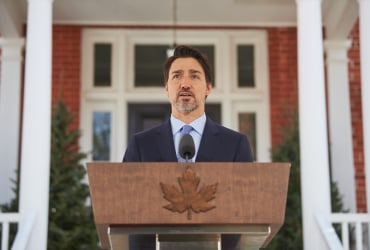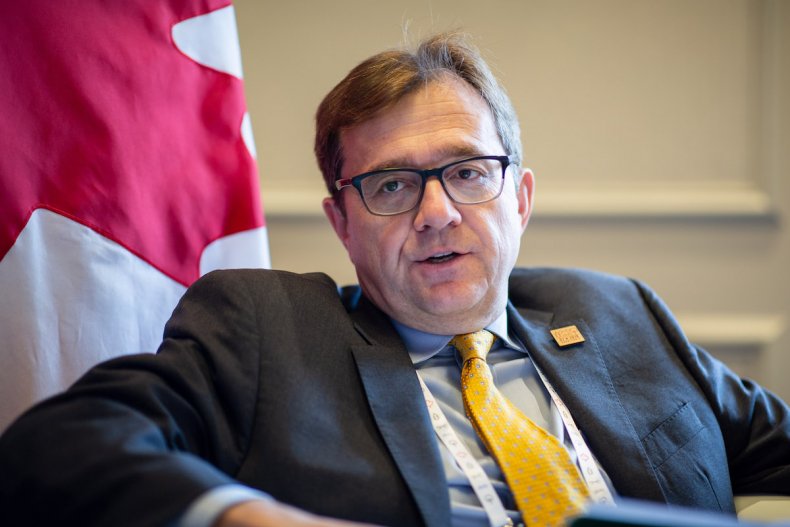On Monday, days before a critical UN climate conference, Canada’s Climate Minister Jonathan Wilkinson admitted that rich countries have failed to reach a critical international climate finance milestone and are unlikely to reach it any time soon. years.
The news came at a virtual press conference hosted by UK COP26 President Alok Sharma, flanked by German Environment Minister Jochen Flasbarth and Wilkinson. Climate ministers from Germany and Canada were selected earlier this year to help close the gap in the minimum $ 100 billion a year in climate finance that rich nations promised to deliver to developing countries in 2009. What The two countries achieved was a plan to have the money available in a few years.
the delivery plan is based on two scenarios considered by the Organization for Economic Cooperation and Development (OECD). One scenario foresees the delivery of 106,000 million dollars by 2023, assuming that countries and multilateral development banks fully comply with the established commitments, while a second scenario, based on a lower private capital investment than previously assumed, foresees the delivery of 101,000 million dollars by 2023.
Both scenarios assume that public finances will lead the effort, with the first scenario projecting US $ 85.3 billion from government coffers, US $ 18.4 billion from the private sector, and US $ 2.6 billion in “loans to export ”by 2023. The second scenario forecasts US $ 82.5 billion of public money, US $ 16 billion of private capital and US $ 2.6 billion of export credits.
“What we have done in this report is raise the level of ambition regarding contributions from donor governments and … we expect to see significant additional mobilization from the private sector, but we have not assumed that in the numbers,” Wilkinson said.
Given a reporting delay of roughly two years, it won’t be known whether rich countries have reached the milestone until 2025, five years after the date it was supposed to be locked. recently reported According to the OECD, in 2019, rich countries invested $ 79.6 in climate finance, a two percent increase from $ 78.3 billion in 2018.
What people are reading

“When the OECD released its most recent report, everyone who read that report knew that we were not going to meet the 2020 target,” Wilkinson said.
“There was certainly disappointment at the time, and I think there was also fear that that goal would not be achieved within a relevant time period,” he said, adding that the delivery plan revealed Monday would offer clarity to developing countries in that the money will be available in 2023.
That’s not good enough, say a number of climate advocates, because climate collapse is accelerating and the world is running out of time to cling to a climate-secure future. The money that is delayed does nothing to help countries that need it now, they say.
“We are nowhere near where we need to be when it comes to helping developing countries take a greener path,” said Harjeet Singh of Climate Action Network International.
“Expecting developing countries to step up in terms of emission reduction targets before putting money on the table is absolutely unfair and inequitable,” he said.
“Not being able to secure $ 100 billion … is a worrying sign for the COP conference next week,” @R_BrooksStand says with @Standearth. #cdnpoli # COP26 #ClimateCrisis
This is in part because the kind of investment needed to keep global warming at 1.5 ° C is known to be measured in the trillions and poorer countries are expected to pay for their own transition to net zero as they grapple with disproportionately to the worst impacts of climate collapse. it will just be too difficult.
“There is a lot of pressure on developing countries to increase ambition, (and) there is a lot of talk about net zero targets,” Singh said. “But when it comes to finances, there is no clear roadmap, and what has been delivered today is a delayed plan.
“Clearly, it erodes trust and doesn’t give developing countries enough confidence to make those policy changes.”

Earlier this year, Canada Announced it would double its international climate finance from $ 2.65 billion to $ 5.3 billion over the next five years. He also announced that he would increase the amount of that money given in donations from 30% to 40%.
Despite the recent commitment, National Environmental Defense Program Manager Dale Marshall says it is important for Canada to go one step further.
“The truth is, despite recent progress in terms of Canada’s promises, Canada is lagging behind in terms of action and ambition,” he said.
“At the G7, Canada’s emissions have increased the most since Paris was agreed, we have the weakest target for 2030 and we provide the most subsidies and public funding for fossil fuel development in absolute terms, although there are countries that are bigger and have more resources. “
Stand.earth’s climate finance director Richard Brooks called it “unforgivable” and “shameful” that rich countries like Canada failed to close the $ 100 billion in climate finance they promised.
“It’s actually quite embarrassing when you think about how much money has been spent spent globally on COVID relief, how much the Canadian government has spent to purchase an oil sands pipeline, how a lot of money goes to fossil fuel subsidies by countries around the world, ”he said.
“There are a lot of money pools, and not being able to secure $ 100 billion … is a worrying sign for the COP conference next week.”
The release of the international climate finance delivery plan came a day before a new report from Stand.earth, Institute for Energy Economics and Financial Analysis, C40, and Wallace Global Fund that found that over the past decade, the divestment movement of fossil fuels has grown. drastically to include nearly 1,500 institutions representing more than $ 39.2 trillion in assets.
“Since the movement’s first summary report in 2014, the amount of total assets publicly committed to divestment has grown by more than 75,000 percent. The number of institutional divestment commitments has grown 720 percent in that time, including a 49 percent increase in just the three years since the movement’s most recent report, ”the report reads.
Brooks said when you have the Queen, the Dad, Harvard University, and New York They all agree on one thing, they know they have made it into the mainstream, but they attributed part of the success of the divestment movement to the failure of governments.
“The fossil fuel divestment movement exists because governments have not taken their responsibility seriously enough when it comes to implementing laws and regulations to curb emissions,” he said.
Brooks said that when the divestment movement began, it was to cut the financial pipeline for fossil fuel companies to limit the ability of new projects to move forward and to undermine the political power of fossil fuel companies. used to delay significant climate action. As such, withdrawing more than $ 39 trillion globally for fossil fuel companies creates room for governments to increase their climate ambition, he said.
“Thirty-nine trillion dollars is nothing to shy away from. That’s a significant amount of capital that is being taken off the table for fossil fuel companies, ”Brooks said. But “we need that number to increase, and to increase rapidly because every dollar that goes to a coal, oil or gas company is a push on the brake pedal when we have to go full throttle.”
Climate finance is expected to be the defining topic on the agenda at COP26 in Glasgow because without rich countries making money available to poorer countries to transition to a clean economy, maintaining the goal of the Paris Agreement 1.5 C will be out of range.
Closing the $ 100 billion gap quickly and setting climate finance targets after 2025 are expected to be key issues, but there are a number of issues to be solved, including increasing funds available for climate loss and damage. and adaptation, rather than mitigating them. technologies like solar panels or electric vehicles that have a clear business case that investors can leverage.
The United Nations conference on climate change, which has been held since 1995, also known as COP, short for Conference of the Parties, brings together politicians, scientists, environmental activists and climate experts to negotiate agreements to reduce warming. global. This year, COP26 will take place at the Scottish Event Campus in Glasgow, Scotland, from October 31 to November 12. The event has been called the “last hope” to achieve the goal of the Paris Agreement in the world.
John Woodside / Local Journalism Initiative / Canada National Observer
Reference-www.nationalobserver.com